Dirt Devils

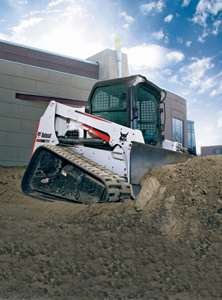
“Contractors are switching or adding compact track loaders to their fleets as they discover the advantages of these machines,” explains Mike Fitzgerald, loader product specialist for Bobcat (currently selling nine models of compact track loaders from the T110 to the T320). “Whether it’s the increased pushing power, the low ground disturbance or the ability to work longer seasons, contractors are finding they can take advantage of a compact track loader to be more productive.
“These units weigh significantly more than skid steer loaders of the same size. That extra weight allows the machine to have higher pushing forces, so compact track loaders particularly excel at grading and excavating applications. These applications may be as simple as rough grading in a new residential area or as complex as a final grade for a new concrete pad that requires a high degree of accuracy.”
Extra power, lower ground pressure, added flotation and traction and the same high-powered attachment system — the advantages of compact track loaders are growing with dirt work professionals. It should be noted a dedicated track undercarriage has its niche — landscape, forest and construction jobs that need that extra flotation, traction and pushing power (while still leaving a light footprint). Wheeled skid steers will always have their strong markets especially when hard surfaces, cost of ownership or increased cycle times come into play, but we expect compact track loaders to continue to eat up market share in their specific applications like earth works.
From Bobcat to Caterpillar, Takeuchi to ASV, Komatsu to Case — 10 manufacturers are producing or branding these dedicated track machines today. If your daily duties include excavating, spreading, grading or just maneuvering through dirt and earth, a compact track loader is a great machine for precise projects and small worksites.
“Tracks make all the difference,” says Rick Harris, international sales manager for Terex Construction Americas (representing seven models of Terex machines). “Compact track loaders have become popular among dirt work professionals because they can do things that skid steer loaders and similar machines simply cannot. Using tracks and a dedicated undercarriage, these units have exceptional flotation, traction and versatility and will work on virtually any material and ground condition. With a very low center of gravity, exceptional stability and great ground clearance, track loaders improve productivity when used on dirt work jobsites — especially on side hills and uneven terrain.”
The Attachment Arsenal
A compact track loader is a utility machine, which means it can shift, change and adapt to your specific dirt operation using its regular-flow (19- to 23-gpm) or high-flow (up to 40-gpm) hydraulic attachment system. Some of the improved productivity in a track loader can be traced to the loader’s operating weight when using these implements. The extra weight allows the machine to have higher pushing forces, so compact track loaders particularly excel at grading and excavating applications. Attachments such as dozer blades, graders, box blades, landplanes, soil conditioners and landscape rakes are great choices for owners who have this dedicated track machine in their fleet. Just with a bucket (not even a backhoe), a track loader can dig.
“Compact track loaders dig extremely well because of the outstanding tractive effort the tracks provide,” assures Kelly Moore, product manager for Gehl Co., which sells five models of rubber-tracked loaders. “For grading, the operator should drive forward slowly, with the lift arm in the fully lowered position and the bucket flat on the ground. Next, he or she should tilt the bucket cutting edge downward slightly, below grade level, and then return the cutting edge back to level as it digs in. After the bucket fills, the operator should rotate the bucket back fully, at which time the bucket should be filled with freshly dug material.”
Every compact track loader comes with a dirt bucket, which can be used for a variety of digging applications from removing topsoil to digging for a pool. Increased weight and lower center of gravity allow track loaders to perform more like mini bull dozers, forcing layers of earth into your bucket for removal.
Typically, with digging comes dozing and track loaders excel at earth work with a sharp steely dozer blade (or better yet a six-way dozer blade). The dedicated undercarriage adds pushing forces that allow the dozer blade to power through complex grades; the unit is also less apt to spin out as it pushes through the material.
“When using a dozer blade, it is important to properly set your angle and depth of cut. Both are affected by soil conditions, the size and power of your track loader and size [width and weight] of the dozer blade,” says George Chaney, JCB skid steer and track loader product manager, noting JCB’s 180T, 190T and 1110T track units. “An experienced operator automatically makes these adjustments as he uses the machine, which greatly improves productivity and machine and attachment effectiveness.”
Blades work in tandem with landplanes and box rakes. If you need to grade, level and pulverize the soil in one pass, a box rake works best. Paired with a compact track loader, nothing works better to prepare the soil for seeding. With a power box rake, you can grade, shape, dig and plow, restoring trenches, windrowing debris, aerating wet soil and reconditioning turf. There are also box rakes and blades with roller levels, which pulverize lumps and clods of soil for a smoother finish with heavy-duty iron. A metal roller actually precedes a blade, delivering reliable, cost-efficient productivity for finished grade work (just expect this attachment to add anywhere from 1,229 to 1,620 lbs to your track loader).
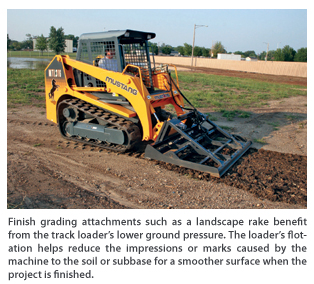
Attach a backhoe implement to the front of a compact track loader and harness the ability to dig small and precise jobs for trenches, footings, basements and drainage ditches (the unit’s extra weight will give your backhoe more stability and power). Backhoe attachments are operated either inside or outside of the track loader cab. Although boom-control backhoes (those operated with the skid steer’s levers) leave something to be desired in the way of arm reach and breakout force, the single-cylinder design to operate the bucket curl takes it easy on the hydraulic system and only requires 10 gpm at 2,000 psi. They are also easy on the wallet, generally starting around $1,800 with an 8-in. bucket and then going up in cost depending on options.
Taking backhoe versatility one step further, some backhoe attachments come with their own set of controls outside the cab with a seat. Patterned in either ISO or SAE operating patterns, this style of backhoe attachment can rival the specifications of a small compact excavator. However, the increased versatility makes more demands on your loader and wallet — the backhoe work tools require between 11 and 22 gpm to operate and around $11,000 to $12,000 to purchase.
Cost is always a factor, so many contractors step back to where they started — with what’s called a general-purpose bucket or more commonly a dirt bucket. Combining a lower capacity (typically 10 to 20 cu ft) with a durable construction, dirt buckets can dig (as we mentioned), but are usually used for moving dirt, rocks and heavier materials such as sand, gravel and earth. Just dig into a pile of dirt and feel the tractive force of your undercarriage force-fill the bucket.
“It’s important to maintain sufficient engine RPMs while digging into a pile to satisfy hydraulic pressure and flow requirements,” advises Chaney. “A common error by less experienced operators is to attempt digging too fast, whereby the engine lugs down too far, consequently stalling out the machine. As most track loaders utilize servo controls, the operator doesn’t have the ‘feel’ as with mechanical controls. This lack of feel or pressure-build in the controls makes it bit more difficult to know when to back off the controls, allowing the engine to recover, regaining engine RPMs.”
Many manufacturers compensate for these situations with servo controls by adding power management systems or anti-stall systems, allowing less experienced operators to be more productive in more demanding dirt applications. Discuss these options with your dealer.
Loading Up the Convoy
Compact track loaders work in tandem with a contractor’s truck brigade. Since track loaders are great dig-and-load machines, they’re also ideal for pick-and-place jobs, moving buckets of spoil and product or even pallets into and out of commercial trucks.
“Dumping into a dump truck would be no different than performing the same maneuver with a skid steer loader,” says Harris. “Approach the truck at a 90-degree angle with lift arm in full down position and bucket in full rolled back position. As the loader approaches the truck as close as possible, the operator should stop its forward movement, then raise the lift arm fully over the side boards of the truck. Once in the needed height position, drive slowly forward to the truck, dumping the bucket when close to the truck chassis. Truck bed heights will vary based on the size of the truck itself, its dump box and height of side boards, but many of them will be at 120 in. or higher.”
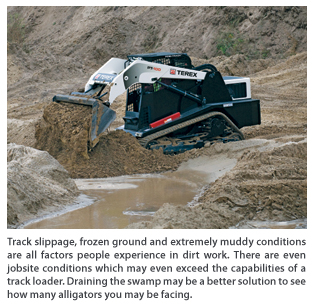
“Komatsu even offers bucket self leveling and two-speed travel as standard equipment on each of their compact track loaders. These features allow faster and more efficient movement of material,” says Bob Beesley, product manager with Komatsu America Corp., makers of the CK30-1 radial lift machine and CK35-1 vertical lift machine.
Each company offers unique options and standard features and nearly everyone’s dedicated track undercarriage is unique (for instance, Terex has an undercarriage suspension system, Bobcat offers a steel track version and most manufacturers have multiple track width options). Cab options abound. Check for things like pilot joystick controls for easiest, fatigue-free operation, both horn and back up alarms and hydraulic self-leveling for maintaining even operations during lift action of the bucket or pallet forks. Deluxe, six-way high back suspension seating is always a plus, standard foot throttle for easy controlling of engine speed is nice and awesomely comfy deluxe cabs are available for real dirty jobs. And when working in more dusty applications, an air pre-cleaner system can be added to the engine to provide for further air screening prior to going into the dual-element filtration system.
Maintenance overall will be more than your average loader, regardless of application with a track loader. Because of the dedicated track undercarriage’s many moving parts (sprockets, idlers, bogie wheels) and high cost of track replacement (about $2,000 a pair), compact track loaders will cost you more in yearly maintenance costs and in initial purchase price. Those cost factors can be somewhat mitigated with constant, proper preventative maintenance of your undercarriage system.
“As dirt and debris accumulate on the loader’s track carriage, it is important to clean off this material regularly, to keep the tracks and rollers free of material,” explains Moore. “Periodic cleaning and pressure-washing is a good idea. And with the more dusty conditions, shorter maintenance intervals on the engine are very important for keeping the machine in top operating condition.”
Pressure washers are most effective at cleaning caked and dried dirt and mud in and around the track undercarriage systems on track loaders. It is always best to clean your machine before the mud has dried. Operators will experience accelerated track undercarriage wear by not maintaining a clean machine as the dirt and debris acts as an abrasive, literally wearing out the tracks and undercarriage components from the inside out. It is always important to utilize a comprehensive preventative maintenance program on any machine. Routine greasing and cleaning when necessary are vital in order to get maximum value out of the machine. Proper operation is equally important.
“Avoid making quick turns by counter-rotating,” says Harris. “This will not only scuff turf and other sensitive surfaces but can cause tracks to wear faster. Make gradual turns whenever possible. At least daily, check to ensure track tension meets the manufacturer’s recommendations. Properly tensioned tracks will last longer and give you the best performance. The operation and maintenance manual is a good place to start when it comes to recommended service and cleaning intervals.”
With these types of operational objectives, crews can rely on a compact track loader to successfully battle dirt jobs, ensuring pleased customers and increased profits. When ground operations need to call in the mobile artillery — that little dirt devil on tracks — you can roll out the attachments, spearheading your earth-driven operations throughout the spring, summer and winter of 2010.
Keith Gribbins is managing editor of Compact Equipment, based in Peninsula, Ohio.
Undercarriage Experts
Kubota Enters the Track Loader Industry
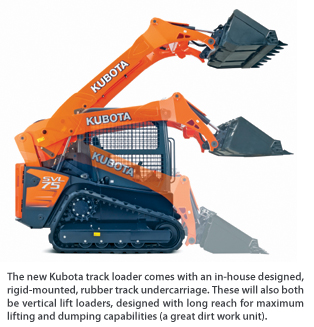
Shown to the public at the World of Concrete trade show in early February, Kubota showcased its all-Kubota designed, engineered and manufactured compact track loader, powered by its own Kubota diesel engine. The new 75- and 90-hp SVL models will be arriving at Kubota dealerships this summer, offering outstanding performance, exceptional comfort, easy maintenance and impressive durability that Kubota has become known for.
The all-new SVL75 compact track loader will deliver 6,530-lb bucket breakout force and a 4,881-lb lifting capacity. The SVL90 has a bucket breakout force of 7,961 lbs and a lift capacity of 5,869 lbs. Both models come with plenty of choices in attachments from buckets to augers to pallet forks. And the Kubota cab model compact track loaders, sporting an enclosed pressurized cab, will be available early in 2011.



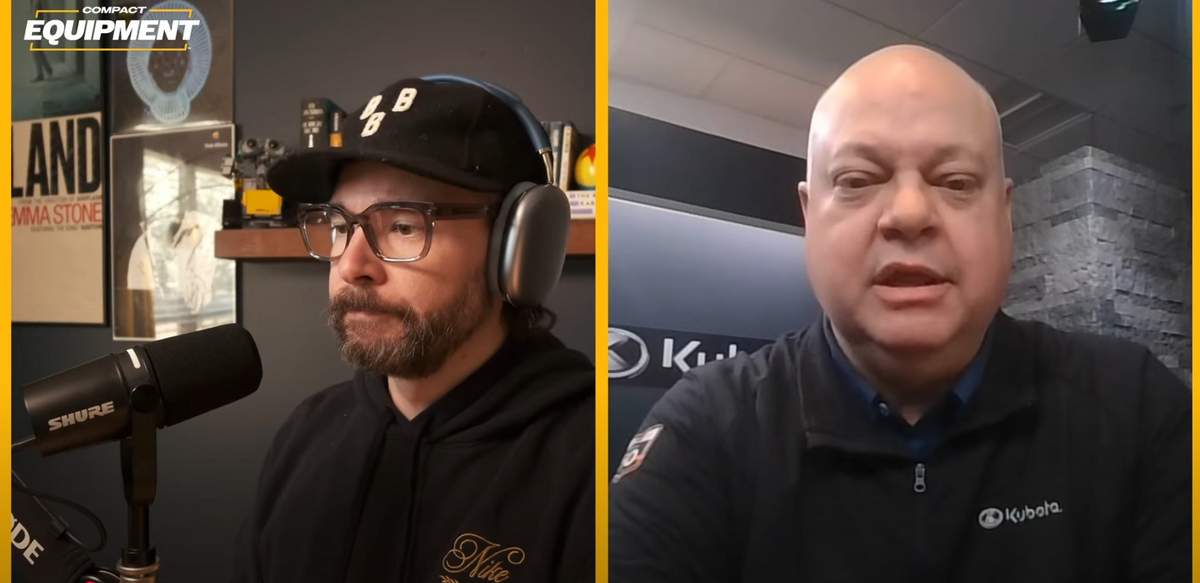
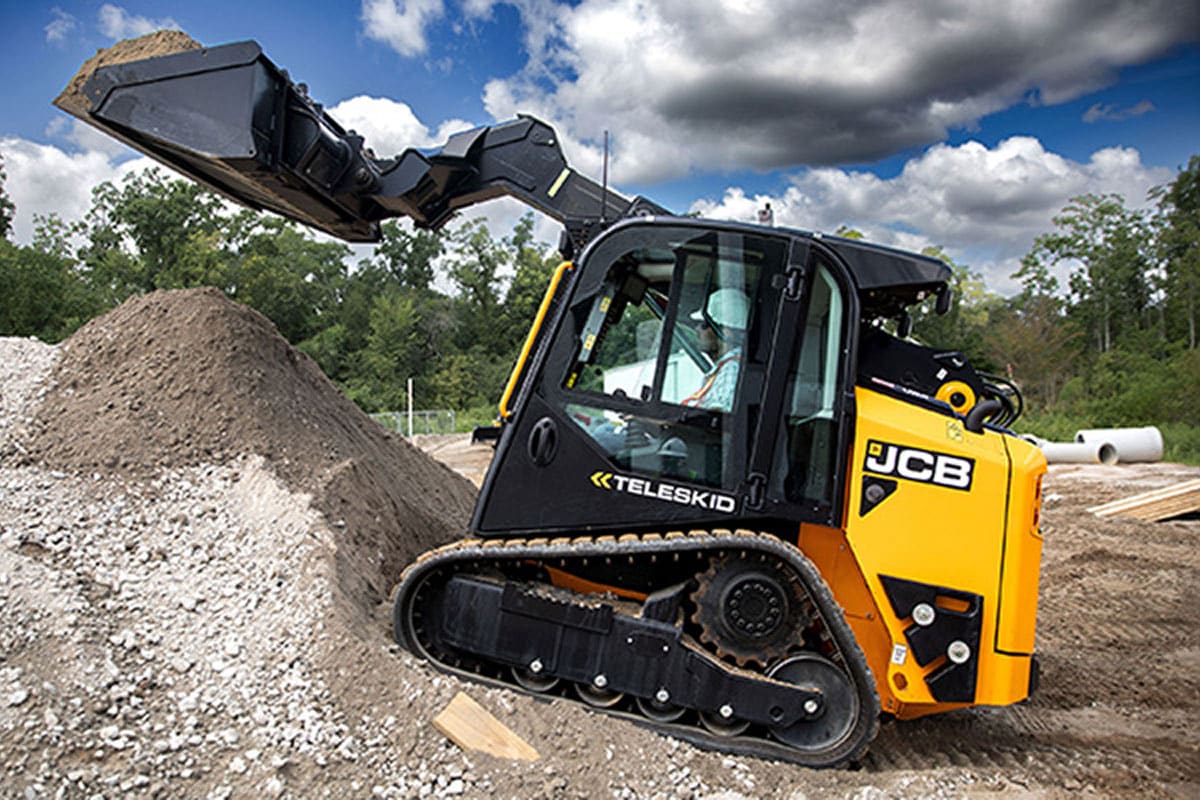
Comments are closed here.